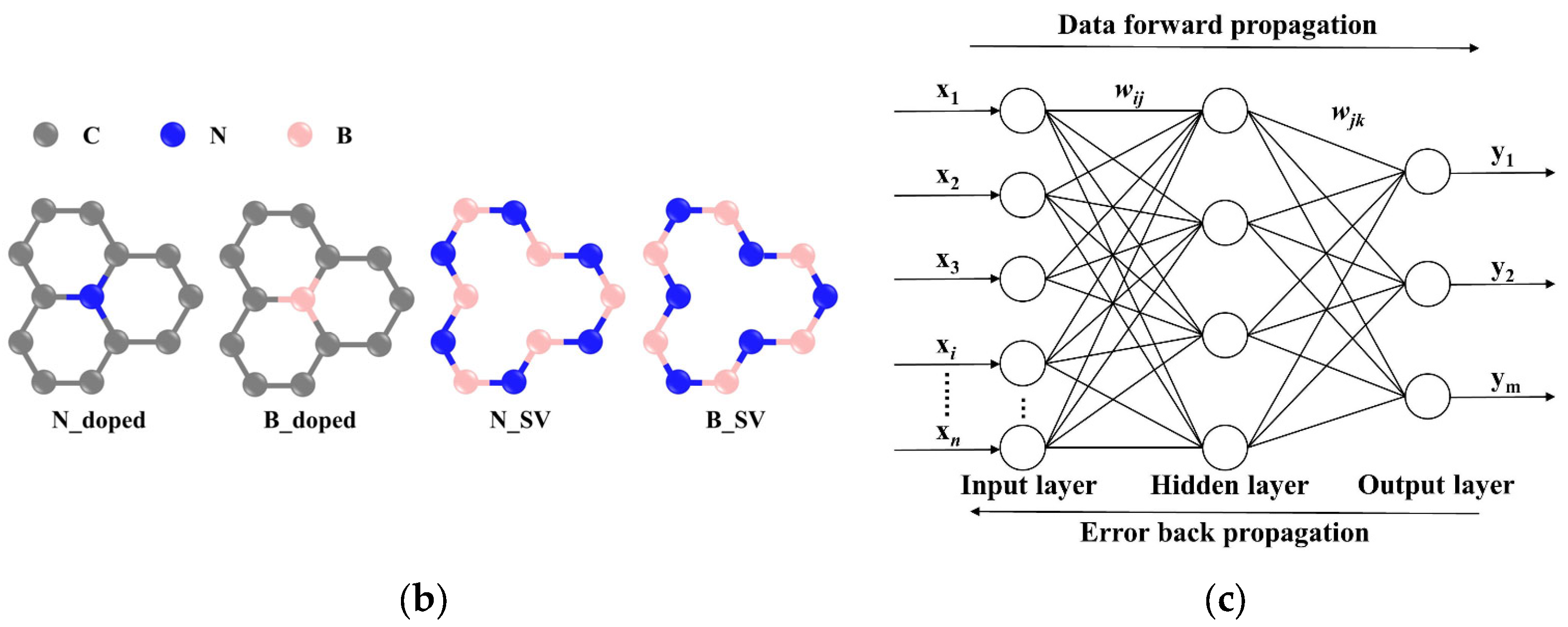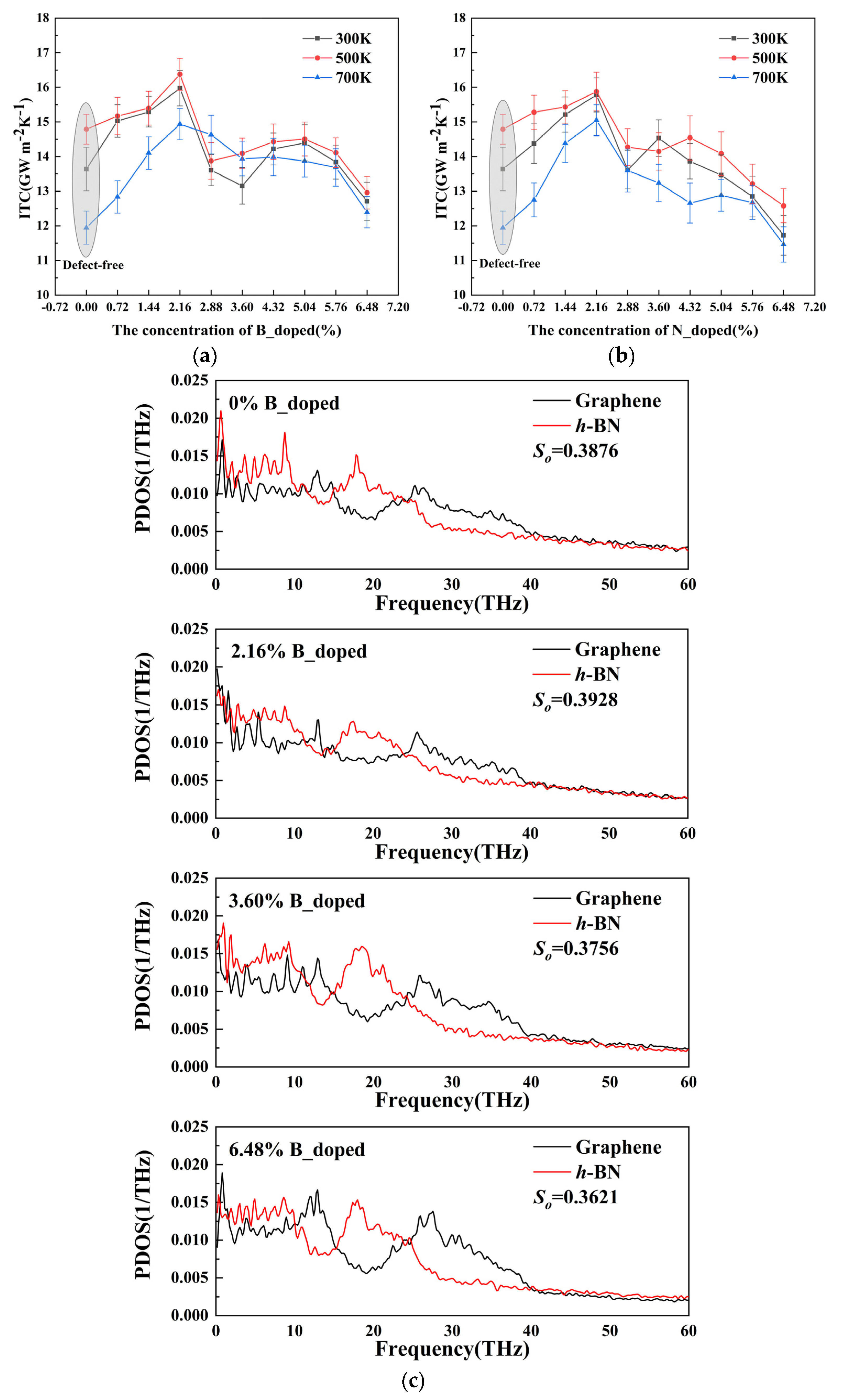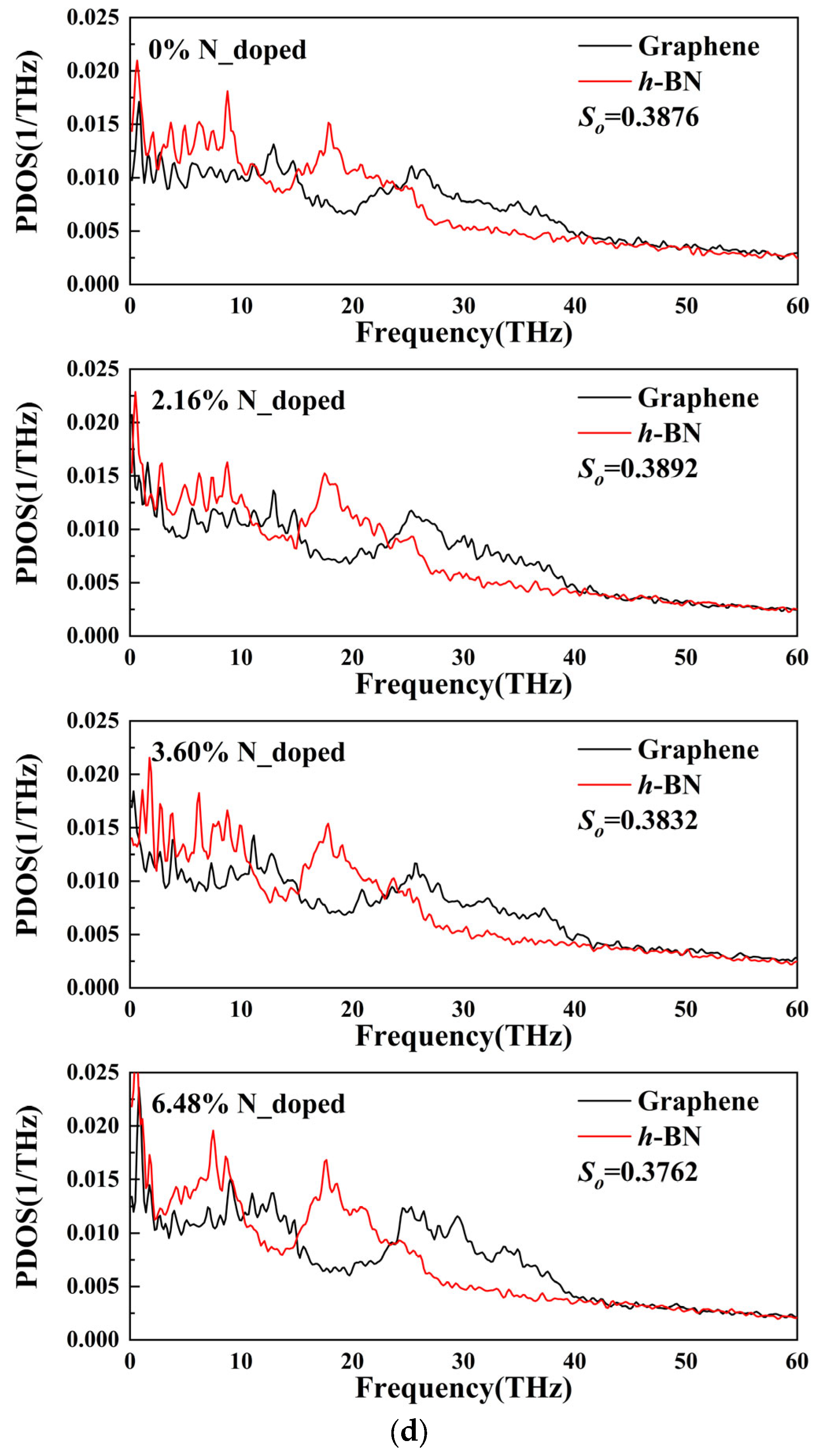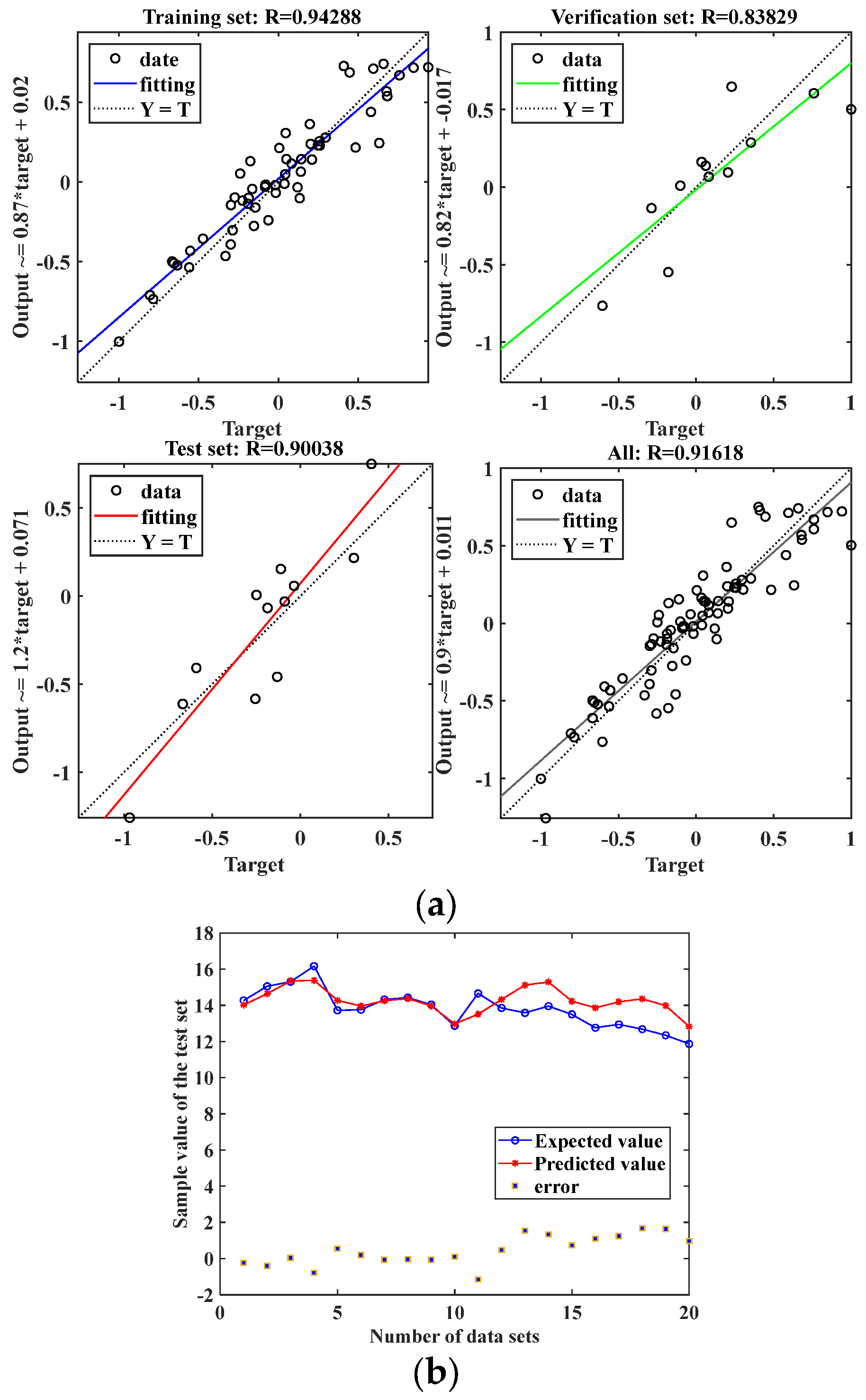Prediction and Control of Thermal Transport at Defective State Gr/h-BN Heterojunction Interfaces
Abstract
1. Introduction
2. Model and Computational Methods
3. Results
3.1. Effect of Doped
3.2. Effect of the Single Vacancy
3.3. The Prediction of ITC
4. Conclusions
Author Contributions
Funding
Data Availability Statement
Conflicts of Interest
References
- Balandin, A.A.; Ghosh, S.; Bao, W.Z.; Calizo, I.; Teweldebrhan, D.; Miao, F.; Lau, C.N. Superior Thermal Conductivity of Single-Layer Graphene. Nano Lett. 2008, 8, 902–907. [Google Scholar] [CrossRef] [PubMed]
- Balandin, A.A. Thermal properties of graphene and nanostructured carbon materials. Nat. Mater. 2011, 10, 569–581. [Google Scholar] [CrossRef]
- Balandin, A.A. Phononics of Graphene and Related Materials. ACS Nano 2020, 14, 5170–5178. [Google Scholar] [CrossRef]
- Guo, Y.N.; Zhang, C.; Chen, Y.; Nie, Z.W. Research Progress on the Preparation and Applications of Laser-Induced Graphene Technology. Nanomaterials 2022, 12, 2336. [Google Scholar] [CrossRef] [PubMed]
- Fu, X.L.; Zhu, Y.H.; Li, J.Z.; Jiang, L.P.; Zhao, X.T.; Fan, X.Z. Preparation, Characterization and Application of Nano-Graphene-Based Energetic Materials. Nanomaterials 2021, 11, 2374. [Google Scholar] [CrossRef]
- Chen, X.K.; Xie, Z.X.; Zhou, W.X.; Tang, L.M.; Chen, K.Q. Thermal rectification and negative differential thermal resistance behaviors in graphene/hexagonal boron nitride heterojunction. Carbon 2016, 100, 492–500. [Google Scholar] [CrossRef]
- Fan, L.; Yao, W.J. Reduction of interfacial thermal transport of bilayer in-plane graphene/hexagonal boron nitride heterostructures via interlayer sp3 bonds, defects and stacking angle. Diam. Relat. Mater. 2021, 118, 108521. [Google Scholar] [CrossRef]
- Wu, X.; Han, Q. Phonon Thermal Transport across Multilayer Graphene/Hexagonal Boron Nitride van der Waals Heterostructures. ACS Appl. Mater. Interfaces 2021, 13, 32564–32578. [Google Scholar] [CrossRef]
- Yang, B.; Peng, C.; Song, M.R.; Tang, Y.P.; Wu, Y.L.; Wu, X.H.; Zheng, H.Y. Thermal Transport of AlN/Graphene/3C-SiC Typical Heterostructures with Different Crystallinities of Graphene. ACS Appl. Mater. Interfaces 2023, 15, 2384–2395. [Google Scholar] [CrossRef]
- Song, J.R.; Xu, Z.H.; Liang, X.G.; He, X.D. Thermal Energy Transport in Graphene/Graphitic Carbon Nitride Film. J. Phys. Chem. C 2022, 126, 9482–9492. [Google Scholar] [CrossRef]
- Wang, X.J.; Yang, D.Z.; Zhang, M.; Hu, Q.; Gao, K.J.; Zhou, J.S.; Yu, Z.Z. Super-Hygroscopic Calcium Chloride/Graphene Oxide/Poly(N-isopropylacrylamide) Gels for Spontaneous Harvesting of Atmospheric Water and Solar-Driven Water Release. ACS Appl. Mater. Interfaces 2022, 14, 33881–33891. [Google Scholar] [CrossRef]
- Kang, Y.; Li, W.C.; Ma, T.; Huang, X.C.; Mo, Y.P.; Chu, Z.Y.; Zhang, Z.J.; Feng, G.T. Microwave-constructed honeycomb architectures of h-BN/rGO nano-hybrids for efficient microwave conversion. Compos. Sci. Technol. 2019, 174, 184–193. [Google Scholar] [CrossRef]
- Desai, J.A.; Bandyopadhyay, A.; Min, M.; Saenz, G.; Kaul, A.B. A photo-capacitive sensor operational from 6 K to 350 K with a solution printable, thermally-robust hexagonal boron nitride (h-BN) dielectric and conductive graphene electrodes. Appl. Mater. Today 2020, 20, 100660. [Google Scholar] [CrossRef]
- Fang, H.M.; Zhang, X.; Zhao, Y.H.; Bai, S.L. Dense graphene foam and hexagonal boron nitride filled PDMS composites with high thermal conductivity and breakdown strength. Compos. Sci. Technol. 2017, 152, 243–253. [Google Scholar] [CrossRef]
- Li, J.L.; Liu, X.X.; Feng, Y.; Yin, J.H. Recent progress in polymer/two-dimensional nanosheets composites with novel performances. Prog. Polym. Sci. 2022, 126, 101505. [Google Scholar] [CrossRef]
- Yin, H.; Sun, Z.H.; Wang, Z.; Tang, D.W.; Pang, C.H.; Yu, X.F.; Barnard, A.S.; Zhao, H.T.; Yin, Z.Y. The data-intensive scientific revolution occurring where two-dimensional materials meet machine learning. Cell Rep. Phys. Sci. 2021, 2, 100482. [Google Scholar] [CrossRef]
- Champa-Bujaico, E.; Garcia-Diaz, P.; Diez-Pascual, A.M. Machine Learning for Property Prediction and Optimization of Polymeric Nanocomposites: A State-of-the-Art. Int. J. Mol. Sci. 2022, 23, 10712. [Google Scholar] [CrossRef]
- Chen, X.Y.; Lv, H.L. Intelligent control of nanoparticle synthesis on microfluidic chips with machine learning. NPG Asia Mater. 2022, 14, 69. [Google Scholar] [CrossRef]
- Ayub, S.; Guan, B.H.; Ahmad, F.; Javed, M.F.; Mosavi, A.; Felde, I. Preparation Methods for Graphene Metal and Polymer Based Composites for EMI Shielding Materials: State of the Art Review of the Conventional and Machine Learning Methods. Metals 2021, 11, 1164. [Google Scholar] [CrossRef]
- De Oliveira, R.F.; Montes-Garcia, V.; Ciesielski, A.; Samori, P. Harnessing selectivity in chemical sensing via supramolecular interactions: From functionalization of nanomaterials to device applications. Mater. Horiz. 2021, 8, 2685–2708. [Google Scholar] [CrossRef]
- Li, X.; Liu, Z.L.; Cui, S.Q.; Luo, C.C.; Li, C.F.; Zhuang, Z. Predicting the effective mechanical property of heterogeneous materials by image based modeling and deep learning. Comput. Methods Appl. Mech. Eng. 2019, 347, 735–753. [Google Scholar] [CrossRef]
- Wan, J.; Jiang, J.W.; Park, H.S. Irreversible crumpling of graphene from hydrostatic and biaxial compression. J. Phys. D-Appl. Phys. 2018, 51, 015302. [Google Scholar] [CrossRef]
- Goncalves, I.; Souza, R.; Coutinho, G.; Miranda, J.; Moita, A.; Pereira, J.E.; Moreira, A.; Lima, R. Thermal Conductivity of Nanofluids: A Review on Prediction Models, Controversies and Challenges. Appl. Sci. 2021, 11, 2525. [Google Scholar] [CrossRef]
- Haque, M.A.; Kee, S.; Villalva, D.R.; Ong, W.L.; Baran, D. Halide Perovskites: Thermal Transport and Prospects for Thermoelectricity. Adv. Sci. 2020, 7, 1903389. [Google Scholar] [CrossRef]
- Wan, X.; Feng, W.T.; Wang, Y.P.; Wang, H.D.; Zhang, X.; Deng, C.C.; Yang, N. Materials Discovery and Properties Prediction in Thermal Transport via Materials Informatics: A Mini Review. Nano Lett. 2019, 19, 3387–3395. [Google Scholar] [CrossRef]
- Yao, W.J.; Fan, L. Defects in Graphene/h-BN Planar Heterostructures: Insights into the Interfacial Thermal Transport Properties. Nanomaterials 2021, 11, 500. [Google Scholar] [CrossRef]
- Bazrafshan, S.; Rajabpour, A. Engineering of thermal transport in graphene using grain size, strain, nitrogen and boron doping; a multiscale modeling. Int. J. Heat Mass Transf. 2018, 123, 534–543. [Google Scholar] [CrossRef]
- Li, M.Y.; Zheng, B.; Duan, K.; Zhang, Y.; Huang, Z.G.; Zhou, H.M. Effect of Defects on the Thermal Transport across the Graphene/ Hexagonal Boron Nitride Interface. J. Phys. Chem. C 2018, 122, 14945–14953. [Google Scholar] [CrossRef]
- Lindsay, L.; Broido, D.A. Optimized Tersoff and Brenner empirical potential parameters for lattice dynamics and phonon thermal transport in carbon nanotubes and graphene. Phys. Rev. B 2010, 81, 205441. [Google Scholar] [CrossRef]
- Kinaci, A.; Haskins, J.B.; Sevik, C.; Cagin, T. Thermal conductivity of BN-C nanostructures. Phys. Rev. B 2012, 86, 115410. [Google Scholar] [CrossRef]
- Liu, X.J.; Zhang, G.; Zhang, Y.W. Thermal conduction across the one-dimensional interface between a MoS2 monolayer and metal electrode. Nano Res. 2016, 9, 2372–2383. [Google Scholar] [CrossRef]
- Wu, B.Y.; Zhou, M.; Xu, D.J.; Liu, J.J.; Tang, R.J.; Zhang, P. Interfacial thermal conductance of BP/MoS2 van der Waals heterostructures: An insight from the phonon transport. Surf. Interfaces 2022, 32, 102119. [Google Scholar] [CrossRef]
- Hu, S.; Zhao, C.Y.; Gu, X.K. Impact of thermostat on interfacial thermal conductance prediction from non-equilibrium molecular dynamics simulations. Chin. Phys. B 2022, 31, 056301. [Google Scholar] [CrossRef]
- Malekpour, H.; Ramnani, P.; Srinivasan, S.; Balasubramanian, G.; Nika, D.L.; Mulchandani, A.; Lake, R.K.; Balandin, A.A. Thermal conductivity of graphene with defects induced by electron beam irradiation. Nanoscale 2016, 8, 14608–14616. [Google Scholar] [CrossRef] [PubMed]
- Malekpour, H.; Balandin, A.A. Raman-based technique for measuring thermal conductivity of graphene and related materials. J. Raman Spectrosc. 2018, 49, 106–120. [Google Scholar] [CrossRef]
- Hong, Y.; Han, D.; Hou, B.; Wang, X.Y.; Zhang, J.C. High-Throughput Computations of Cross-Plane Thermal Conductivity in Multilayer Stanene. Int. J. Heat Mass Transf. 2021, 171, 121073. [Google Scholar] [CrossRef]







| Parameters | C | N | B |
|---|---|---|---|
| A (eV) | 1393.6 | 128.86866 | 40.0520156 |
| B (eV) | 430 | 138.77866 | 43.132016 |
| (Å−1) | 3.4879 | 2.8293093 | 2.2372578 |
| (Å−1) | 2.2119 | 2.6272721 | 2.0774982 |
| 0.00000015724 | 0.019251 | 0.0000016 | |
| n | 0.72751 | 0.6184432 | 3.9929061 |
| c | 38.049 | 17.7959 | 0.52629 |
| d | 4.3484 | 5.9484 | 0.001587 |
| h | −0.930 | 0.0000 | 0.5000 |
| R (Å−1) | 1.95 | 2.0 | 2.0 |
| D (Å−1) | 0.15 | 0.1 | 0.1 |
| Parameters | Range of Values | Unit | |
|---|---|---|---|
| Input Factor | N_SV | 0–6.48 | % |
| B_SV | 0–6.48 | % | |
| N_doped | 0–6.48 | % | |
| B_doped | 0–6.48 | % | |
| Temperature | 300–700 | K | |
| Output Factor | ITC | 6.73–14.97 | Gw m−2K−1 |
Disclaimer/Publisher’s Note: The statements, opinions and data contained in all publications are solely those of the individual author(s) and contributor(s) and not of MDPI and/or the editor(s). MDPI and/or the editor(s) disclaim responsibility for any injury to people or property resulting from any ideas, methods, instructions or products referred to in the content. |
© 2023 by the authors. Licensee MDPI, Basel, Switzerland. This article is an open access article distributed under the terms and conditions of the Creative Commons Attribution (CC BY) license (https://creativecommons.org/licenses/by/4.0/).
Share and Cite
Zhou, M.; Liu, L.; Liu, J.; Mei, Z. Prediction and Control of Thermal Transport at Defective State Gr/h-BN Heterojunction Interfaces. Nanomaterials 2023, 13, 1462. https://doi.org/10.3390/nano13091462
Zhou M, Liu L, Liu J, Mei Z. Prediction and Control of Thermal Transport at Defective State Gr/h-BN Heterojunction Interfaces. Nanomaterials. 2023; 13(9):1462. https://doi.org/10.3390/nano13091462
Chicago/Turabian StyleZhou, Mingjian, Liqing Liu, Jiahao Liu, and Zihang Mei. 2023. "Prediction and Control of Thermal Transport at Defective State Gr/h-BN Heterojunction Interfaces" Nanomaterials 13, no. 9: 1462. https://doi.org/10.3390/nano13091462
APA StyleZhou, M., Liu, L., Liu, J., & Mei, Z. (2023). Prediction and Control of Thermal Transport at Defective State Gr/h-BN Heterojunction Interfaces. Nanomaterials, 13(9), 1462. https://doi.org/10.3390/nano13091462







